PAGE IS CURRENTLY UNDER WORK
Pokemon:Diamond and Pearl
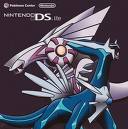
Platform:Nindendo DS
Pokémon Diamond (ポケットモンスター ダイヤモンド, Poketto Monsutā Daiyamondo?, Pocket Monsters Diamond) and Pokémon Pearl (ポケットモンスター パール, Poketto Monsutā Pāru?, Pocket Monsters Pearl) are a pair of role-playing video games developed by Game Freak and published by Nintendo for the Nintendo DS handheld video game console.
Pokémon Diamond and Pearl add an extensive amount of new features, such as Internet play over the Nintendo Wi-Fi Connection,[1] while building on older game concepts such as Pokémon Contests.[2] Set in the fictional region of Sinnoh, the games cover the adventure of a single protagonist embarking on a quest to capture and train Pokémon while simultaneously thwarting the agenda of the criminal organization Team Galactic.

Pokémon Battle Revolution (ポケモンバトルレボリューション, Pokemon Batoru Reboryūshon?) is the first Pokémon game on Nintendo's Wii home console. It is also the first Wii game to use the Nintendo Wi-Fi Connection in North America and Japan and the first Wii game to wirelessly interact with the Nintendo DS handheld.[3]
Pokémon Battle Revolution features eleven different colosseums in a new land, a Pokémon-themed theme park called Pokétopia.[4][5] Other announced features include stadiums that have their own special effects, such as randomizing the order of one's Pokémon. Some other effects are choosing the order of an opponent's Pokémon and setting level limitations.
Pokemon Ranger Bottanage

Platform:Nintendo DS
Not Much is known about this game...
Pokemon Mystery Dungeon Time and Darkness

Pokémon Mystery Dungeon: Explorers of Time (ポケモン不思議のダンジョン 時の探検隊, Pokémon Fushigi no Danjon Toki no Tankentai?, lit. "Pokémon Mystery Dungeon: Time Exploration Team") and Pokémon Mystery Dungeon: Explorers of Darkness (ポケモン不思議のダンジョン 闇の探検隊, Pokémon Fushigi no Danjon Yami no Tankentai?, lit. "Pokémon Mystery Dungeon: Darkness Exploration Team") are a matched pair of Pokémon games for the Nintendo DS. The two games were released in Japan on September 13, 2007, and is set to be released in North America on April 20, 2008.[1]
A 21-minute TV special based on the game starring Kurumi Mamiya aired in Japan on September 9, 2007 as a content of the program relating Pokémon, "Pokémon Sunday" produced by TV Tokyo Corporation. The special will air in the USA on Cartoon Network prior to the games release on April 20, 2008.
There is a guild for beginners. It includes multiple rooms with new Pokémon on every floor. The town remains the same from the original Mystery Dungeon with some changes to the shop owners. Two examples of owner changes are Duskull replacing Persian at the Poké Bank, and Marowak replacing Makuhita with the Poké Gym.
More than 490 Pokémon will be included to be obtainable;[2] although, some will require Wondermail to unlock the event. Shaymin and Arceus have not been officially revealed by Nintendo yet, so they have not been included in the game. This game will focus on exploring in dungeons rather than rescuing. Most starting Pokémon from the first game will be reappearing in this game, though a few of them will be replaced by the current fourth generation starters. Despite rumors that have spread early on, Riolu is not one of the available starters: the only fourth-generation Pokémon available as starters are Turtwig, Chimchar, Piplup,and Munchlax. Most legendary Pokémon can be recruited like the first game but for some, a special item known as the Enigma Part, ancient Stone Plate or wonder mail code will be required. Also, each version will have its own exclusives; Pokémon that are only available in that specific version, for example Celebi will only be in Explorers of Time and Mewtwo will only be in Explorers of Darkness. Most exclusive Pokémon can be unlocked in each version by using Wonder Mail codes. However, both Celebi and Mewtwo can only be unlocked in their respective edition: Mewtwo in Darkness and Celebi in Time.
The story is promised to be even more developed than its predecessor, and the issue of the thinning of the relationship between the player and his or her partner will be taken into consideration. There are also species related items which only affect certain Pokémon.
Every Ones Pokemon Ranch

Everyone's Pokémon Ranch (みんなのポケモン牧場, Minna no Pokemon Bokujō?) is a Pokémon video game developed for the Wii by Ambrella.[1] Everyone's Pokémon Ranch was released via the WiiWare download service on March 25, 2008 in Japan. It's expected to be released in North America on May 12, 2008 and can be downloaded for 1000 Wii points.
Overview
Everyone's Pokémon Ranch allows players to transfer up to 1,000 of their Pokémon from Diamond and Pearl to a farm run by a woman named Yukari. Here they can view their Pokémon (rendered in 3D) while using their Miis to interact with them.
Players do not need to own Pokémon Diamond and Pearl to play Everyone's Pokémon Ranch. Players without the DS title will be given 6 starter pokémon including pikachu and will be given a new pokémon at the start of everyday.
Players can transfer up to 20 Pokémon a day. Additionally, each day Yukari will give the player requests for certain Pokémon not in the player's Pokédex to be added to the farm, along with clues on where to find them in Diamond and Pearl. Upon fulfilling these requests, the player will gain new items such as a bell that calls the Pokémon to the player.
Yukari can also trade certain Pokémon she already has in her possession. Eventually, transferring more Pokémon to the farm unlocks new features to the game and to the farm itself.[2]
Similar to the actions in the Mii Channel's plaza, the Pokémon on the farm can perform different idle actions, such as talking and playing with each other and sleeping. Players are also able to take snapshots of their Pokémon and send them to friends registered on their Wii.[3] A simple HUD shows the ability to monitor the time and the number of Pokémon in the ranch.
Apart from storing collected Pokémon on the farm, players are otherwise unable to further train or level up their Pokémon on the farm.[2]
Super Smash Bros. Brawl
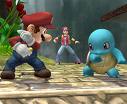
Super Smash Bros. Brawl (大乱闘スマッシュブラザーズX, Dairantō Sumasshu Burazāzu Ekkusu?, lit. "Great Melee Smash Brothers X") is a crossover fighting game developed by Sora and published by Nintendo for the Wii console.[6] As the third installment of the Super Smash Bros. series, Brawl's character roster expands from that of its predecessor, and is the first in the series to feature third-party characters.[7] Most of the game's music is made up of arranged versions of pieces from previously released video games helmed by 39
Pokemon Snap

Pokémon Snap (ポケモンスナップ, Pokemon Sunappu?) is a video game developed by HAL Laboratory and published by Nintendo for the Nintendo 64. It is part of the Pokémon series, and was first released in North America on June 30, 1999[2].
Pokemon Ranger
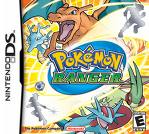
Pokémon Ranger is an action/role-playing video game developed by HAL Laboratory and published by Nintendo for the Nintendo DS video game console. The game was released at various dates, varying between continents. The game was first released in Japan on March 22, 2006 and was later released in North America and Australia during the remainder of 2006. The game's final release date was in Europe in April 2007.
Pokémon Ranger is compatible with Pokémon Diamond and Pearl, also for the Nintendo DS, allowing players to transfer the egg of the legendary Pokémon Manaphy to a Pokémon Diamond or Pokémon Pearl game. This game is set in the Fiore region
Pokemon Mystery Dungeon Blue and Red Rescue Team
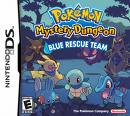
Platform:Nintendo DS
Pokémon Mystery Dungeon: Blue Rescue Team (ポケモン不思議のダンジョン 青の救助隊, Pokemon Fushigi no Danjon Ao no Kyūjotai?) and Pokémon Mystery Dungeon: Red Rescue Team (ポケモン不思議のダンジョン 赤の救助隊, Pokemon Fushigi no Danjon Aka no Kyūjotai?) are a matched pair of Pokémon games for the Nintendo DS and Game Boy Advance, respectively. These two games were developed by Chunsoft and were published by Nintendo.
This game is the ninth entry in Chunsoft's Fushigi no Dungeon series (which began on the Super Famicom with Torneko no Daibōken). It is a semi-turnbased dungeon crawl; a graphical roguelike. The two versions are compatible with each other through the Nintendo DS dual-slot features, where information may be transferred from one game to the other.
The two versions are mostly identical, with the Blue version taking advantage of the dual-screen features and increased graphical capabilities of the Nintendo DS (thus the team's condition can appear on one screen in Blue while playing in the other, while this screen must be accessed through a menu in Red). The game also begins with six Pokémon exclusive to each version. Unlike other games, however, players may unlock the exclusive Pokémon from the other version through Wonder Mail missions.
As of July 25, 2007, Pokémon Mystery Dungeon: Blue Rescue Team has sold 3.08 million copies worldwide.[1]
A 21-minute TV special based on the game, entitled "Pokémon Mystery Dungeon: Team Go-Getters Out Of The Gate!", aired in the USA on September 8, 2006. A six-part manga serial based on the games, entitled Pokémon Mystery Dungeon: Ginji's Rescue Team, was also released in Japan by CoroCoro Comics and in the USA by Viz Kids.
Pokemon Trozei
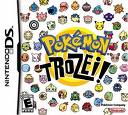
Platform:Nintendo DS
Pokémon Trozei! (ポケモントローゼ, Pokemon Torōze?, also known as Pokémon Link! in Europe) is a Pokémon-themed puzzle game for the Nintendo DS, much like Pokémon Puzzle League and Pokémon Puzzle Challenge. It was released in Japan on October 20, 2005, in Europe on April 28, 2006, in South Korea on May 17, 2007, and in North America on March 6, 2006, where its marketing jingle was "Pokémon, Trooo-Zei! Four in a row and you're good to go!".
Pokemon Ruby and Sapphire

Platform:GBA
Pokémon Ruby and Pokémon Sapphire, released in Japan as Pocket Monsters Ruby and Pocket Monsters Sapphire (ポケットモンスター ルビー・サファイア, Poketto Monsutā Rubī, Safaia?), released on March 17, 2003 in North America for the Game Boy Advance, mark the beginning of the third generation in the Pokémon series of RPGs. Ruby and Sapphire were succeeded in 2004 by Pokémon FireRed and LeafGreen and in 2005 by an enhanced remake titled Pokémon Emerald. The games feature 386 species of Pokémon.
Pokemon Fire Red and Leaf Green

Platform:GBA
Pokémon FireRed (ポケットモンスター ファイアレッド, Poketto Monsutā Faiareddo?, Pocket Monsters Firered) and Pokémon LeafGreen (ポケットモンスター リーフグリーン, Poketto Monsutā Rīfugurīn?, Pocket Monsters Leafgreen), are two titles in the Pokémon video game series, released for the Game Boy Advance in 2004 and they were first compatible with the Game Boy Advance Wireless Adapter (Bundled with these games). They are enhanced remakes of the original Pocket Monsters Aka (Red) and Midori (Green) video games, released in North America and Europe as Pokémon Red and Blue.
The games were released on January 29, 2004 in Japan, September 9, 2004 in North America, and October 1, 2004 in Europe. Players could also obtain the game early at the Pokémon Center New York on August 28, 2004, as part of a special pre-release event for players who pre-ordered the game.
FireRed and LeafGreen feature the original 151 Pokémon from the original Game Boy games, along with many others from later games in the series. This feature allows many of these Pokemon to be obtained for the first time in the newer games, as the original Game Boy and Game Boy Color games are incompatible with Game Boy Advance games. The upgraded games bring the Kanto region Pokémon, and experience to the third generation of Pokémon (the Advanced generation). These games finally complete the loop; allowing players to catch all 386 Pokémon that existed at the time, since many of the Kanto (and Johto) Pokémon are unavailable in Ruby, Sapphire, and Emerald.
The two games are compatible with other Game Boy Advance and GameCube Pokémon RPGs, including Ruby, Sapphire, and Emerald; Pokémon Colosseum and XD; and the utility program Pokémon Box. This compatibility is unlocked after beating the entire game and completing a side-quest.
Pokemon Emerald
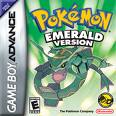
Platform:GBA
Pokémon Emerald, released in Japan as Pocket Monsters Emerald (ポケットモンスター エメラルド, Poketto Monsutā Emerarudo,?), is a title in the Pokémon series of video games. It was released for the Game Boy Advance in Japan on September 16, 2004, in North America and Hong Kong on May 1, 2005, in Australia on June 9, 2005, and in Europe on October 21, 2005. It features the Dragon-type Legendary Pokémon Rayquaza on the cover.
The game is an enhanced remake of Pokémon Ruby and Sapphire, adding to the third generation of Pokémon games. Like the games it was based on, the player controls a Pokémon trainer, whose general goal is to traverse around the Hoenn region and conquer a series of eight Pokémon gyms to earn eight Gym Badges, then take on the Elite Four, defeat the Pokémon League Champion and succeed him/her. Like Ruby and Sapphire, the game features the third generation Pokémon, but also adds some second generation Pokémon that were once limited to Pokémon Colosseum. The National Pokédex is also available without trading.
The game follows the same storyline as Ruby and Sapphire, but adds new elements such as the Battle Frontier, where the player can enter a variety of areas with different Pokémon competitions.
Pokemon Colosseum

Platform:Game Cube
Pokémon Colosseum (ポケモンコロシアム, Pokemon Koroshiamu?) is the first GameCube incarnation of the Pokémon video game franchise. It follows the idea of the Nintendo 64 Pokémon Stadium video game series. The game was released in Japan on November 21, 2003, and was released in North America on March 23, 2004. It was released in Europe on May 7, 2004. It was released in Australia on June 24, 2004. It has since been followed up by Pokémon XD: Gale of Darkness, a 2005 sequel to this game.
Pokémon Colosseum puts significantly less importance on the non-RPG aspects of the game than Pokémon Stadium and Pokémon Stadium 2. For example, there are no minigames, nor is there a Gym Leader Tower. While it is the first 3D Pokémon video game with an RPG mode, it doesn't allow the player to use rental Pokémon the way the Pokémon Stadium games did. This was probably done because Pokémon are obtainable in the RPG mode, thus most of the features in the game are still usable without a Game Boy Advance Pokémon game or rentals. This title features support for the Pokémon Ruby, Sapphire, Emerald, FireRed and LeafGreen games.
It features all 386 known Pokémon as of the third generation. The game features a first for the Pokémon series, a true 3D role-playing game mode that allows the player to capture Pokémon that cannot be captured in the Ruby/Saphire/Emerald game generation, allowing them to eventually be transferred into said games. This includes Legendary Pokémon such as Ho-Oh, Entei, Raikou and Suicune. It also adds a new Pokémon status, Shadow Pokémon, in which this game's plot revolves around. These Pokémon can't be traded to any game until they lose their Shadow status, and are effectively forbidden from use outside the Story mode until
Pokemon XD Gale of Darkness

Platform:Game Cube
Pokémon XD: Gale of Darkness, released in Japan as Pokémon XD Yami no Kaze Dark Lugia (ポケモンXD 闇の旋風ダーク・ルギア, Pokemon Ekkusudī Yami no Kaze Dāku Rugia?, lit. "Pokémon XD: Whirlwind of Darkness Dark Lugia"), is the second console role-playing game from Nintendo’s Pokémon franchise for the Nintendo GameCube. It is the successor of the GameCube game Pokémon Colosseum. The game takes place in Orre, the setting of Pokémon Colosseum’s adventure mode. All of the Game Boy Advance Pokémon games can connect to this game through trading and Battle Mode
Title.
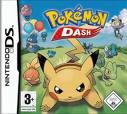
Platform:Nintendo DS
Pokémon Dash is a racing video game. It is notable for being the first Pokémon racing game and the first Pokémon game to be released for the Nintendo DS. It was a launch title in Japan, Europe and Australia. Dash was developed by Ambrella, who also developed Hey You, Pikachu! and Pokémon Channel.
Pokemon Channel

Platform:Game Cube
Pokémon Channel, released in Japan as Pokémon Channel ~Pikachu to Issho!~ (ポケモンチャンネル ~ピカチュウといっしょ!~, Pokémon Channeru ~Pikachū to Issho!~?, lit. "Pokémon Channel ~Together With Pikachu!~") is a virtual pet video game for the GameCube, developed by Ambrella. Its focus is the adventures the player has with Pikachu, most of them involving a new television network. The game can be considered the spiritual sequel to Hey You, Pikachu!.
Pokemon Box

Platform:Gamecube
Pokémon Box: Ruby and Sapphire, or Pokémon Box, is one of the Pokémon games on the Nintendo GameCube console and it was bundled with a Nintendo GameCube Game Boy Advance cable and Memory Card 59. It was released in Japan on May 30, 2003 and in North America on July 11, 2004, but only through the New York Pokémon Center and its online store [1]. However, it is no longer available in either location.
Europeans could get it by purchasing it using points from Nintendo of Europe's loyalty program, VIP 24:7, or by buying the Pokémon Colosseum Mega Pak, which contains a black GameCube, an extra memory card, Pokémon Colosseum, Pokémon Box, and a cable to connect the GameCube with a Game Boy Advance.
Title.
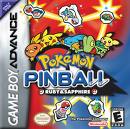
Platform:GBA
Pokémon Pinball: Ruby & Sapphire is a pinball game based on Pokémon Ruby and Sapphire, and is the sequel to Pokémon Pinball for the third generation of Pokémon games.
Pikachu DS Tech Demo

Paragraph.
Pokemon Red and Blue
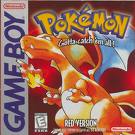
Platform:Game Boy
Pokemon Red Version (the first Pokemon game that came out in America and the one that started it all)and Blue verson is really intresting,not because of the Pokemon but because of the glitches,this game has many glitches because it was the first game...This game takes place in the Kanto region were your mission is to be the master of Pokemon your rival will be Gary or whatever you name him.You have to earn 8 badges and defeat the Elite Four BUT! it will not be that easy you will come across many obsticles and the worst of them all are those annoying Team Rocket! after you beat the game and after the credits a Mewtwo will be waiting for you inside the Cerulean Cave....
Title.

Platform:GB
Pokémon Yellow: Special Pikachu Edition is the fourth game in the Pokémon video game series in Japan, and the third in North America and Europe. The game was released in Japan on September 12, 1998 as Pocket Monsters Pikachu (ポケットモンスターピカチュウ, Poketto Monsutā Pikachū?). It was released in North America on October 1, 1999 and was called Pokémon: Special Pikachu Edition by Nintendo. In both regions, the games are often referred to by fans as simply Pokémon Yellow, Pokémon Yellow Version,Yellow Version, or Pokémon Pikachu. Along with the release of Pokémon Yellow, a special edition yellow Pokémon Game Boy Color was also released.
The game was essentially a remake of the previous two versions, Pokémon Red and Blue, though it featured changes to make the game more similar to the animated series. Like Ash Ketchum in the anime, trainers in the game received Pikachu as their starter Pokémon. The game was very successful and became the top selling handheld game for weeks after its release. The game entered the Guinness Book of Records in 2001 for selling one million copies within a span of one month.
Pokemon Gold and Silver
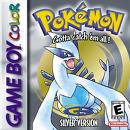
Platform:GBC
Pokémon Gold and Pokémon Silver, released in Japan as Pocket Monsters Kin and Pocket Monsters Gin (ポケットモンスター 金・銀, Poketto Monsutā Kin, Gin?, lit. "Pocket Monsters Gold, Silver"), are two Game Boy video games. Released in 2000, these games started the second generation of the vastly popular Pokémon video game series. These games feature a new region called Johto, 100 new Pokémon and many more additions. They are also backward compatible with the first generation of games (Pokémon Red, Blue and Yellow).
Pokemon Crystal
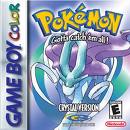
Platform: GBC
In Pokemon Cr
Pokemon Puzzle League Challenge
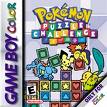
Paragraph.
Pokemon Puzzle League

Platform:Nintendo 64
Pokemon Puzzle League is a game were there is not much battling involved....you don't even know how to play Pokemon to play this game.This game is the only Pokemon game that came out in the U.S.A. This game features the Gym Leaders,Elite Four,Service Spa,and the Pokemon Mansion.When playing this game you will come by some ,mini clips of the anime at the end after you defeat Mewtwo you.........uhh....just beat the rest of the game...
Pokemon Green

Platform:GBC
THE GAME THAT STARTED IT ALL
Pokemon Pinball
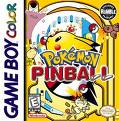
Platform:GBC
Pokémon Pinball (ポケモンピンボール, Pokemon Pinbōru?) is a pinball game based on Pokémon Red and Blue. In it, the ball is a Poké Ball, and most of the objects on the table are Pokémon-related. It was rated an 8/10 by Electronic Gaming Monthly. The game is also forward-compatible with the original Game Boy, as shown by it's black colored scheme shared by other forward compatible Game Boy Color games.
Pokemon Stadium

Platform:Nintendo 64
Pokemon Stadium is a really thrilling game, you could learn some strageties this a includes the Battle Tower were you could battle Gym Leaders of the Kanto region,the GB tower were you could play your Red,Blue,and Yellow Version if you have the pack to insert in,also it includes Prof.Oaks Lab you can check out the status of your Red, Blue, Yellow version also you can trade there too if you have more than 2 pack, there is also a Stadium were all the trophes are held there is 4 diffrent kind of cups involving certan rules,and if you want a little brake there is the Mini Games you don't really need to know about Pokemon for this you only need to know the rules. And if you think your almost done with every thing think again!There is a part 2 after you deafeat the ultimate Pokemon (MEWTWO) and then you will have to rebattle him again at the end of part 2......Good Luck
Pokemon Stadium 2

Platform:Nintendo
If your really into Pokemon Stadium 1 Then theres a garantee you will like this games it has some stuff that the original Pokemon Stadium had including battling Gym Leaders ,Mini Games ,Gamboy place,also some same cups in the original Pokemon Stadium .The new things it has is mew attacks and Pokemon this game will be a little more challenging than the original Pokemon Stadium
